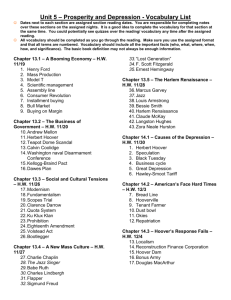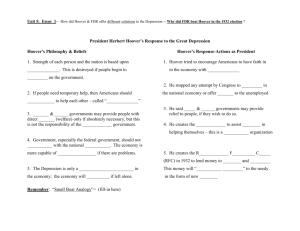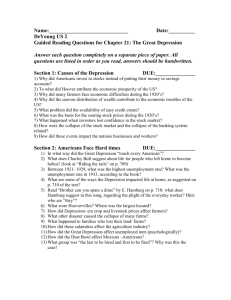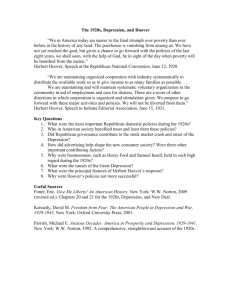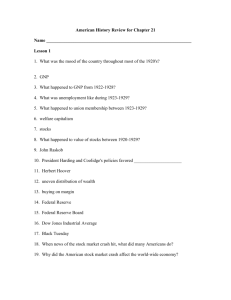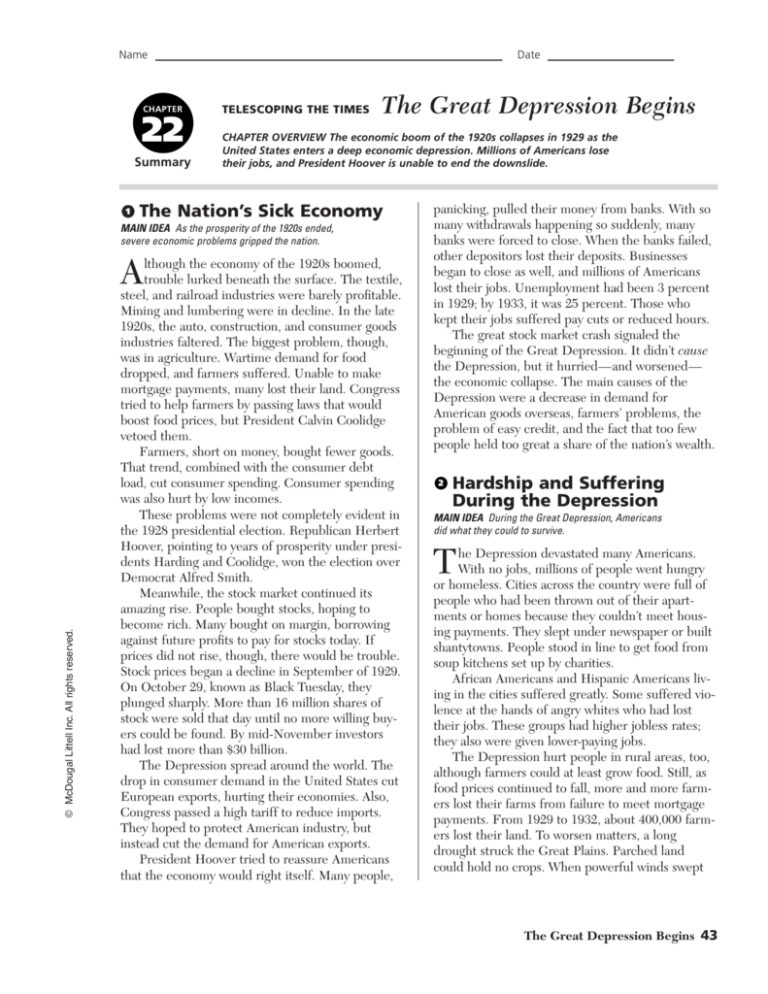
Name
CHAPTER
22
Summary
1
Date
TELESCOPING THE TIMES
The Great Depression Begins
CHAPTER OVERVIEW The economic boom of the 1920s collapses in 1929 as the
United States enters a deep economic depression. Millions of Americans lose
their jobs, and President Hoover is unable to end the downslide.
The Nation’s Sick Economy
MAIN IDEA As the prosperity of the 1920s ended,
severe economic problems gripped the nation.
© McDougal Littell Inc. All rights reserved.
A
lthough the economy of the 1920s boomed,
trouble lurked beneath the surface. The textile,
steel, and railroad industries were barely profitable.
Mining and lumbering were in decline. In the late
1920s, the auto, construction, and consumer goods
industries faltered. The biggest problem, though,
was in agriculture. Wartime demand for food
dropped, and farmers suffered. Unable to make
mortgage payments, many lost their land. Congress
tried to help farmers by passing laws that would
boost food prices, but President Calvin Coolidge
vetoed them.
Farmers, short on money, bought fewer goods.
That trend, combined with the consumer debt
load, cut consumer spending. Consumer spending
was also hurt by low incomes.
These problems were not completely evident in
the 1928 presidential election. Republican Herbert
Hoover, pointing to years of prosperity under presidents Harding and Coolidge, won the election over
Democrat Alfred Smith.
Meanwhile, the stock market continued its
amazing rise. People bought stocks, hoping to
become rich. Many bought on margin, borrowing
against future profits to pay for stocks today. If
prices did not rise, though, there would be trouble.
Stock prices began a decline in September of 1929.
On October 29, known as Black Tuesday, they
plunged sharply. More than 16 million shares of
stock were sold that day until no more willing buyers could be found. By mid-November investors
had lost more than $30 billion.
The Depression spread around the world. The
drop in consumer demand in the United States cut
European exports, hurting their economies. Also,
Congress passed a high tariff to reduce imports.
They hoped to protect American industry, but
instead cut the demand for American exports.
President Hoover tried to reassure Americans
that the economy would right itself. Many people,
panicking, pulled their money from banks. With so
many withdrawals happening so suddenly, many
banks were forced to close. When the banks failed,
other depositors lost their deposits. Businesses
began to close as well, and millions of Americans
lost their jobs. Unemployment had been 3 percent
in 1929; by 1933, it was 25 percent. Those who
kept their jobs suffered pay cuts or reduced hours.
The great stock market crash signaled the
beginning of the Great Depression. It didn’t cause
the Depression, but it hurried—and worsened—
the economic collapse. The main causes of the
Depression were a decrease in demand for
American goods overseas, farmers’ problems, the
problem of easy credit, and the fact that too few
people held too great a share of the nation’s wealth.
2
Hardship and Suffering
During the Depression
MAIN IDEA During the Great Depression, Americans
did what they could to survive.
T
he Depression devastated many Americans.
With no jobs, millions of people went hungry
or homeless. Cities across the country were full of
people who had been thrown out of their apartments or homes because they couldn’t meet housing payments. They slept under newspaper or built
shantytowns. People stood in line to get food from
soup kitchens set up by charities.
African Americans and Hispanic Americans living in the cities suffered greatly. Some suffered violence at the hands of angry whites who had lost
their jobs. These groups had higher jobless rates;
they also were given lower-paying jobs.
The Depression hurt people in rural areas, too,
although farmers could at least grow food. Still, as
food prices continued to fall, more and more farmers lost their farms from failure to meet mortgage
payments. From 1929 to 1932, about 400,000 farmers lost their land. To worsen matters, a long
drought struck the Great Plains. Parched land
could hold no crops. When powerful winds swept
The Great Depression Begins 43
The Great Depression Begins continued
Name
3
Hoover Struggles with
the Depression
MAIN IDEA President Hoover's conservative response
to the Great Depression drew criticism from many
Americans.
E
conomic slowdowns happen with some frequency. President Hoover at first believed that
the Depression was simply another slowdown that
would end. Officials in his administration thought it
best to do nothing and let the economy heal itself.
Hoover believed government should take action,
but be careful not to take too much power.
Hoover thought that the government’s role
should be to help different groups work together to
improve the economy. He also believed that the
government should encourage private groups to
provide benefits—food and shelter—to the needy
and jobless. He did not think that the government
should provide direct aid to people, however.
Hoover met with bankers, business leaders,
and labor leaders. He urged them to work together to revive the economy. Despite these efforts,
44 Unit 6, Chapter 22
the economic situation simply got worse. People
expressed their frustration at the situation. Farmers destroyed some food or refused to work.
People without homes began to call their shantytowns “Hoovervilles.”
Hoover did not change his principles and offer
direct aid to the jobless and hungry. He did take
steps to have a more active government role in the
economy, however. He began a program of major
public works, including building roads, bridges, and
dams, to provide jobs. He launched a program to
try to raise food prices and urged bankers to join a
credit organization that would shore up ailing
smaller banks.
By 1932, the economy had still not improved.
Congress passed a law to lower the rates for home
mortgages, hoping to spur the construction industry. Hoover created the Reconstruction Finance
Corporation, aimed at funding projects that would
create jobs. The RFC was a major change in policy,
but it came too late to help.
Hoover’s popularity plummeted even further in
1932 when World War I veterans came to Washington. They demanded early payment of the
bonuses they had been promised. This Bonus Army
began to live in tents near the Capitol building.
Hoover helped them, but after Congress voted
down the bill they had requested, he told the veterans to leave. About 2,000 stayed, and Hoover
ordered the army to remove them. The sight of
U.S. army troops gassing American citizens—
including children—outraged many people. Hoover
faced the 1932 presidential campaign more unpopular than ever.
Review
1. What caused the Great Depression?
2. What affect did the Depression have on different
groups of people in society?
3. How did the Depression affect the family?
4. How did President Hoover’s response to the
Depression change over time?
© McDougal Littell Inc. All rights reserved.
the plains, they blew the soil away in vast dust
storms. An area known as the Dust Bowl was hardest hit. Many farmers packed up their belongings
and moved to California to find work as migrant
farm workers.
The Depression placed heavy pressures on the
family. Many men felt ashamed because they had
lost their jobs. Some abandoned their families.
Women found work if they could, but they generally were paid less than men. Some people, too,
argued that employers should hire men rather than
women since they were seen as the primary support for a family.
Children suffered from poor diets and lack of
health care. The number of children suffering illnesses due to lack of vitamins increased. Lacking
money to continue, many school boards shut down
schools or shortened the school year. Many children
went to work to try to help their families survive.
Others rode the railways in search of better lives.




